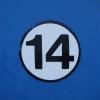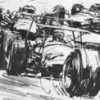And, while we're at it, the name "Swiss Formula 3 Championship" is actually not quite correct, because it was the
Schweizerische Automobilmeisterschaft für Rennwagen,
Championnat Suisse Automobile des Voitures de Course - the Swiss Racing Car Championships, dating back to 1926 when a certain Hermann Kracht of Zürich won the first such title, in a Type 35 Bugatti. That year, seperate Championships for Touring, Sports and Racing Cars in each of the acknowledged international capacity classes were to be awarded, but in the Racing Car category only Kracht recorded the stipulated minimum number of results (already then, a Swiss speciality!) by winning the Engelberg (May 30), Eaumorte (Jun 13), Walzenhausen (Jun 27) and Klausen (Aug 8) hill climbs in the 2000 cc Class E. The same year, there were five champions each in the Touring and Sports Car categories! Another Bugatti driver, Josef Merz of Zürich won the 1927 Racing Car title, and while the Champion in 1928 is not very clear (it may have been August Scheibler of Laupen near Berne on a Fiat), the 1929 winner was yet another Bugatti driver, Hans Stuber of Berne.
For a time in the thirties, the seperate category championships were discontinued, and only two overall titles were awarded for "expert" and "amateur" drivers, respectively. By 1938, the Racing Car Championship was back in the form of a "Gold Medal of the ACS" with Max Christen of Zürich the winner in his 2-litre Maserati, who repeated the following year as the Champion proper. More importantly, however, 1939 saw the introduction of the (in)famous
Leistungsprinzip as the scoring method for the Swiss Championships for all categories, which was only discarded completely following the 1979 season (in 1977 already for the Sports and Racing Car categories). Some of you may remember the thread in which I applied this scoring method to the 1970 World Championship Formula One season, with the result that Jochen Rindt ended up in 12th place instead of being Champion - it was THAT wacky!!

As eccentric and convoluted as it may appear for us today, it was actually and quite probably not the very worst solution for the particularity of a small country with a sense of individuality and freedom that may be unique in Europe, and certainly was for its time! In Switzerland, everybody who wishes to compete is welcome to do so, no matter whether in his road-going Mini or 2CV, or last year's Formula One Ferrari! A multitude of categories, classes and divisions takes care of the various performance levels of all entries, and some form of comparison of the results simply had to be found to arrive at only three National Champions per year for Racing, Sports and Touring Cars, respectively (a fourth title for "Grand Touring" cars was added in 1957, renamed "Special Cars" in 1970 when the Touring Cars became "Stock Cars").
The
Leistungsprinzip, actually invented by the Swiss Motorcycle Federation a few years earlier, was the pride and joy of the ACS, who regarded it as the only "fair" way to award championships, though in reality it probably rewarded plodder quality over excellence, and transpiration over inspiration. Mostly, however, it favoured the guy who was lucky in picking the class he was going to compete in: a low car count and a relative lack of talent amongst one's class mates was the best ticket for championship success. Another weak point was the frequency of ties at the head of the table, like in that 1939 Racing Car Championship: only Max Christen and Bernard Blancpain of Fribourg in his 1.5-litre Maserati scored the necessary four results that year, and with both having won their class four times, the better average speed (!) of Christen in his bigger Maser at the Bremgarten race proved decisive.
One of the nice things about the Swiss Racing Car Championships was the number of exotic cars competing, and after the war gap the title went twice to Emmanuel de Graffenried of Frbourg in his Formula One Maserati (1949 & '50), then twice to Rudolf Fischer of Zürich in his Formula Two Ferrari (1951 & '52). In 1954, Willy Daetwyler of Zürich won on a big supercharged 4.5-litre Alfa Romeo, then Hansjörg Gilomen of Lengnau near Biel took two in his little 1100 cc Cooper (1954 & '55) before Albert Leuenberger of Lausanne took his turn in a 1200 cc Cisitalia (1956). Harry Zweifel of Glarus (halfway between Zürich and Liechtenstein) took four in a row (1957 - '60) in various F 2 and F 1 Coopers, then Karl Foitek of Zürich a couple in a Formula Junior Lotus (1961 & '62). Charles Vögele of Neftenbach near Winterthur in an Intercontinental Brabham (1963) and André Périat of Porrentruy near the French border in a Junior Cooper (1964) marked time before the "arrival" of Walter Habegger of Herzogenbuchsee/Oberönz near Solothurn as a three-time Champion (1965 - '67) in Brabham and Lotus F 2 cars - Habegger had been runner-up six times before that (including three years in a row tied on points with Champion Zweifel!!), and finished in the top 3 every year bar one from 1956 till '68!
Formula 3 drivers Jürg Dubler of Dielsdorf near Zürich (Brabham, 1968) and Roland Salomon of Frauenkappelen near Berne (Tecno, 1969) paved the way for the seventies and Xavier Perrot of Zürich in his F 2 March (1970 & '71) and Jo Vonlanthen of Frauenfeld near Konstanz in an F 3 Tecno (1972), before Salomon came back in an F 2 March/BMW 732 himself for a couple of
da capos (1973 & '74). Markus Hotz of Sulgen near Konstanz took his brand new March/BMW 752 to the championship in 1975, then a new
nom de course appeared on the scene and dominated the 1976 season in a Formula Atlantic Modus: "Ruby", who turned out to be none other but the recently and very publicly retired (and now secretly unretired) Roland Salomon! In 1977, it was the turn again of Markus Hotz in another brand new March/BMW 772, but the seeds for the future had already been sown with the introduction of a class of its own for the two-litre Formula 3 cars, which hitherto had been lumped together with the Atlantics, Super Vees and what-have-you.
That year, Rolf Egger of Fribourg in a Ralt/Toyota RT1 won five of the 12 championship rounds in the new class, took two seconds, three thirds and a fourth to wind up second in the points chase to Hotz, who had virtually no opposition in taking ten wins in the F 2 class - only Fredy Amweg in his home-built Formula 2 special made it into the top ten in points, a very distant ninth. By contrast, four other F 3 drivers joined Egger in the top ten, with Fritz Straumann in his semi-works Chevron/Toyota B38 in fourth with three wins, two seconds and two thirds, as well as other race winners Dieter Wälti (5th in a March/Toyota 743-77) and Louis Maulini (8th in a Ralt/Toyota RT1). The other two wins fell to Fridolin Wettstein and Armin Conrad, both in Ralt/Toyota RT1s, while Heinz Loosli was tenth in points in his March/Toyota 753-77 on the strength of seven top eight finishes, including a third. Other top 3 finishers were Ruggero Grüt (March/Toyota 743), Hasi Kaufmann (Chevron/BMW B38), Luciano Arnold (March/Toyota 763-77), Laurent Ferrier (Lola/BMW T670) and Bruno Huber (Argo/Toyota JM1).
Edited by Michael Ferner, 05 February 2019 - 23:56.
















